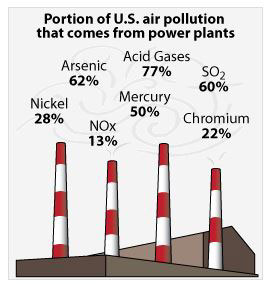As coal use has declined in North America and Europe, toxic air pollution has dropped too – mercury emissions, for example, are down 30% since 1990, according to the US Geological Survey.
And that’s bound to decrease further now that China – which consumes half the world’s coal – is reining it in. About 9% of its coal capacity will be eliminated in the next few years with new mines banned and 4300 small, inefficient mines closing, announced the government.
The goal is to ease oversupply and reduce pollution, responsible for an incredible 4000 deaths a day. There’s still enough production to kill the planet, but the slowdown is significant – the biggest coal mine approved in Australia isn’t starting operations because there isn’t enough demand.

For the past two years, China’s coal consumption dropped for the first time – 2.9% in 2014, and 5-8% in 2015, according to the Institute for Energy Economics and Financial Analysis. Last year, China pledged to cut emissions from coal-fired power plants 60% by 2020.
In another nail in the coal coffin, members of the 34-nation Organization for Economic Cooperation and Development (OECD) agreed they will no longer finance new inefficient coal-fired power plants, cutting off public funding for 85% of coal plants in the pipeline.
That’s great news because OECD is the biggest financier of coal, largely through export subsidies. From 2007-2014, over $73 billion in public finance was approved for coal, led by Japan and South Korea, says a report by Oil Change International, Natural Resources Defense Council (NRDC), and World Wildlife Fund (WWF).
How About the US?
As for the US, coal production declined 10% last year, bringing it to the lowest levels since 1986, according to the US Energy Information Agency. But even with dozens of coal companies declaring bankruptcy in the past few years, utilities have a surplus of 100 million tons.
"U.S. coal consumption is declining dramatically as coal-fired power plants are shutting down. Coal is being displaced by renewables and natural gas, and the Asian markets that all coal companies were looking to as their saviors are moving in the opposite direction," Ross Macfarlane, senior advisor with Climate Solutions, told ThinkProgress.
With a third of US coal-fired power plants closed or about to close (200 so far), carbon emissions from the power sector are at a 20-year low – at 1995 levels!, reports Sierra Club.
That is within 5% of what’s required under EPA’s Clean Power Plan by 2022. Coal was 36% of the power mix last year, down from 50% just 10 years ago, they say.
Another big let-down for coal companies is a new moratorium on leases on federal public lands.
Bankruptcies
But coal companies aren’t giving up – they are restructuring, shedding debt or merging. They continue operating, cutting production slightly or even raising it in some cases, even though the glut will surpress prices even more for years.
"Data from past restructurings show that steps taken in bankruptcy sometimes even boost production by attracting new owners or improving the returns from individual mines," says Bloomberg Intelligence in a report.
Arch Coal, the second largest coal miner in the US and the latest to file for bankruptcy, says it plans to cut production 7.7% this year, but return to higher levels next year. Its stock plunged from $260 a share in 2011 to under $1 when it made the bankruptcy announcement, but Arch will push on. It plans to give lenders equity in exchange for letting it off the hook for $4.5 billion of debt and a $275 million loan for operating funds.
What happens to the public lands these coal miners destroy when they go belly up? Taxpayers pay to restore it. Companies must pay "reclamation bonds" to get a mining permit, but once they are in financial trouble that reverts to mere promises.
Meanwhile, the Washington Coal Club gave Senator Mitch McConnell (R-KY) its "Annual Achievement Award" for his attempts to block EPA’s Clean Power Plan.
And Republicans are up in arms over updated rules from the Interior Department that prevent coal miners from permanently polluting streams, destroying drinking water sources, increasing flood risk, and threatening forests. In other words, they can’t just dump their mining waste into streams anymore. They will have to test streams before and after mining and restore them to their previous condition. The House just voted to block it.
Read our article, Global Emissions Fall This Year, Coal Use Peaked in 2013!
